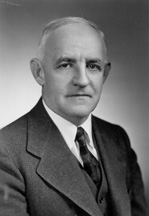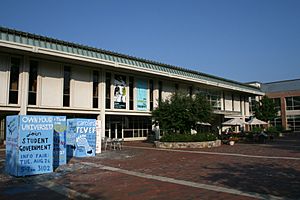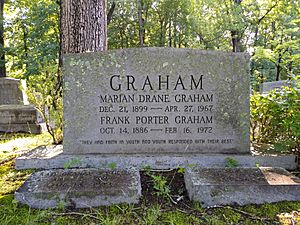Frank Porter Graham facts for kids
Quick facts for kids
Frank Graham
|
|
|---|---|
 |
|
| United States Senator from North Carolina |
|
| In office March 29, 1949 – November 26, 1950 |
|
| Appointed by | W. Kerr Scott |
| Preceded by | Melville Broughton |
| Succeeded by | Willis Smith |
| President of the University of North Carolina System | |
| In office 1930–1949 |
|
| Preceded by | Harry Woodburn Chase |
| Succeeded by | Gordon Gray |
| Personal details | |
| Born | October 14, 1886 Fayetteville, North Carolina, U.S. |
| Died | February 16, 1972 (aged 85) Chapel Hill, North Carolina, U.S. |
| Political party | Democratic |
| Spouse | Marian Drane |
| Relatives | Moonlight Graham Edward Kidder Graham |
| Education | University of North Carolina, Chapel Hill (BA, LLB) Columbia University (MA) |
Frank Porter Graham (born October 14, 1886 – died February 16, 1972) was an important American educator and political activist. He was a history professor who became President of the University of North Carolina at Chapel Hill in 1930. Later, he became the first President of the entire University of North Carolina system.
Graham strongly supported many ideas like academic freedom (the right to teach and learn freely), fairness in the economy, and equal rights for all people. He also worked for world peace. He advised Presidents Franklin Roosevelt and Harry Truman. In 1949, he was chosen by North Carolina's governor to be a United States Senator. He tried to win an election the next year but lost to a conservative politician named Willis Smith.
In 1951, he became a United Nations mediator. This meant he helped try to solve the Kashmir dispute between India and Pakistan. He worked on this difficult task for 16 years. He kept working on other important issues until he retired in 1967 due to poor health.
Contents
Early Life and Education
Frank Porter Graham was born in Fayetteville, North Carolina, in 1886. He was one of nine children. His father, Alexander Graham, was a school superintendent for 25 years. Many of Frank's family members were teachers. His older brother, Archibald Wright "Moonlight" Graham, was a professional baseball player. He later became a doctor. He was even the inspiration for a character in the movie Field of Dreams.
Graham went to the University of North Carolina at Chapel Hill (UNC). He graduated with high honors in 1909. He was a very active student. He was the editor of the school newspaper and yearbook. He also led the debating society and was the head cheerleader. After college, he studied law and became a lawyer in 1913. He earned another degree from Columbia University in 1916.
While studying law, Graham taught at a high school in Raleigh, North Carolina. In 1915, he became a history teacher at UNC. He stopped teaching for a short time to join the United States Marine Corps in 1917. He served in World War I and left the Marines as a first lieutenant in 1919. After the war, he returned to UNC. He became a professor in 1927 and also served as Dean of Students.
Leading the University of North Carolina
In June 1930, Frank Graham was chosen to be the President of UNC. He didn't want the job at first because he loved teaching. But everyone voted for him, so he accepted. His official ceremony was held in Kenan Stadium because so many people came. Graham used the day, Armistice Day, to share his belief. He said schools should guide young people away from war. His cousin, Edward Kidder Graham, had also been President of UNC.
In July 1931, he married Marian Drane. Her father, a church leader in Baltimore, performed the wedding. Just a few months later, in November 1932, Graham was chosen for an even bigger role. He was asked to lead the combining of North Carolina's three public colleges for white students. This created the University of North Carolina system. It included UNC at Chapel Hill, the North Carolina College for Women (now University of North Carolina at Greensboro), and State College (now North Carolina State University).
He led this university system for 17 years. Everyone knew him as "Dr. Frank" because he was friendly and easy to talk to. He was also involved in national groups for universities. He helped create the Southern Council on International Relations. This group worked to teach about world studies in Southern schools.
Graham also wanted to make college sports fairer. In 1935, he helped create the "Graham Plan." This plan aimed to stop special treatment for college athletes. It also wanted to make football less important in colleges. The plan was adopted by the Southern Conference, a group of colleges including UNC. However, it was later changed because some colleges felt it put them at a disadvantage.
Working for the Government
In 1934, President Franklin Roosevelt asked Graham to lead a group. This group made ideas that led to the Social Security Act. This law helps people with money for retirement and other needs. Graham also worked with the National Recovery Administration.
In 1938, Graham led a committee that wrote a report. This report showed how difficult economic conditions were in the South. President Roosevelt shared this report to bring attention to the problem. After this, Graham helped start the Southern Conference for Human Welfare. This group worked to help people in poverty and support new government programs.
During World War II, Graham served on the National War Labor Board. He worked hard to make sure African Americans received fair pay and equal treatment at work.
After President Roosevelt died, President Harry Truman also asked Graham for help. In 1946, Truman appointed him to the President's Committee on Civil Rights. However, in 1947, Graham was questioned by a government committee. They thought a group he was involved with might have ties to Communists. Graham denied this, but some people still had doubts about his political views.
Around this time, Graham also started working with the United Nations. In 1947, President Truman asked him to join a UN group. This group was trying to bring peace to the Indonesian National Revolution. Graham helped start direct talks between Indonesian and Dutch leaders. After returning, he advised the Secretary of State on Indonesian issues.
United States Senator
In 1948, W. Kerr Scott became the Governor of North Carolina. He was a Democrat who supported President Truman's policies. In 1949, the current U.S. Senator from North Carolina, J. Melville Broughton, died. Governor Scott had to choose someone to fill the empty Senate seat. After much thought, Governor Scott chose Frank Graham. This surprised many people.
Graham had never run for or served in a political office before. This was unusual for a senator from North Carolina at that time.
1950 Election Race
In 1950, Graham ran for election to keep his Senate seat. He faced two opponents in the Democratic primary election. One was former Senator Robert R. Reynolds, and the other was Willis Smith. Reynolds was eliminated. Graham received 49% of the vote, and Smith received 41%. Graham needed 50% to win right away. Smith could have chosen not to have a second election, but he changed his mind after supporters rallied for him.
In the second election, called a runoff, Smith ran as a Democrat who was against President Truman's ideas. Smith's supporters used tactics that stirred up fears about an integrated society. They strongly disliked Graham's progressive views.
At that time, many African-Americans in North Carolina could not vote due to Jim Crow laws. Those who could vote were often Republicans. So, Graham could not get many black votes. He also did not call for immediate integration. Graham was not a natural campaigner. He found it hard to ask people for their votes. His political ideas were different from many people in North Carolina.
Because of these factors, Smith won the election by a small margin (52% to 48%). Graham's supporters tried a write-in campaign for the main election, but Smith won easily.
After the Senate
After his short time as a Senator, Graham returned to global diplomacy. He went back to the United Nations. He served as a mediator for India and Pakistan in the Kashmir dispute from 1951 to 1967. He retired from the U.N. in 1967 when he was 81 years old. He then returned to Chapel Hill after his wife passed away.
Death and Legacy
Frank Porter Graham died in Chapel Hill when he was 85. He is buried at the Old Chapel Hill Cemetery.

Many places and groups are named after Frank Porter Graham:
- The student union at UNC-Chapel Hill is named in his honor. It has student services, an art gallery, a movie theater, and even bowling lanes.
- The UNC-Chapel Hill Graduate School created the Frank Porter Graham Honor Society in 1993. It honors students and teachers who provide "outstanding service" to the university.
- The Frank Porter Graham Child Development Institute was started in 1966. It is one of the oldest and largest centers that researches public policy for children and families.
- The Frank Porter Graham Elementary School in Chapel Hill and a building at the University of North Carolina at Greensboro are also named after him.
- Since 1968, the North Carolina chapter of the ACLU gives the Frank Porter Graham Award. This award recognizes people who work to protect civil liberties in the state.
- A documentary film about his life, Dr. Frank: The Life and Times of Frank Porter Graham, was made in 1994.



